DOT&PF Employee Recognition Awards: 2021
2025 | 2024 | 2023 | 2022 | 2021 | 2020
Commissioner’s Office / Administrative Services Division
Daniel Trubiano
DEPARTMENT EMPLOYEE OF THE YEAR NOMINEE
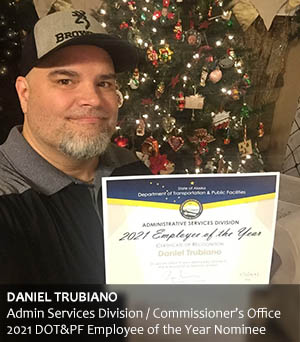 Dan is dedicated to the Central Region Procurement team and is known for his ability to make sure all assigned tasks and office commitments are met in a timely manner. When challenges presented this past year with several long periods of staff shortages due to various health related issues, Dan made himself available to his co-workers, end users, and vendors to help navigate the situation. He leads Central Region Procurement team through multiple complex projects and the changing work environment to make sure the department was successful. Dan is known for his willingness to stop everything he is doing to assist others with their tasks to ensure people received what they need, when they need it, and all at the right price. Recognizing the staff shortages and the overall volume of work coming in, Dan performed an exceptional job over the year while taking minimal personal leave to ensure the work was performed in the absence of other critical staff. Dan's work habits this past year have set a great example for those who work with him. He routinely answers phone calls, emails and follows up with everyone he interacts in a timely manner in an effort to keep Alaska moving and meet our mission.
Dan is dedicated to the Central Region Procurement team and is known for his ability to make sure all assigned tasks and office commitments are met in a timely manner. When challenges presented this past year with several long periods of staff shortages due to various health related issues, Dan made himself available to his co-workers, end users, and vendors to help navigate the situation. He leads Central Region Procurement team through multiple complex projects and the changing work environment to make sure the department was successful. Dan is known for his willingness to stop everything he is doing to assist others with their tasks to ensure people received what they need, when they need it, and all at the right price. Recognizing the staff shortages and the overall volume of work coming in, Dan performed an exceptional job over the year while taking minimal personal leave to ensure the work was performed in the absence of other critical staff. Dan's work habits this past year have set a great example for those who work with him. He routinely answers phone calls, emails and follows up with everyone he interacts in a timely manner in an effort to keep Alaska moving and meet our mission.
In the last year, Dan has, with a positive attitude and without fail, taken on additional work duties and continued to show exceptional commitment to his job and his co-workers without question. Dan is a leader, a team player and an asset to the department and has established himself to be nothing less than an outstanding employee.
Taylor White
OUTSTANDING EMPLOYEE
Since joining the Civil Rights Office (CRO) two years ago, Taylor has been a pillar of customer service and support. His position is a vital component of the CRO team, and he has provided a much-needed high level of administrative professionalism and expertise.
Taylor's work ethic and dedication to the department has been exceptional and has not gone unnoticed. Some of his accomplishments include establishing new finance processes to ensure the CRO is able to support DBE firms and OJT apprentices and trainees. He has written and updated desk manuals, standard procedure manuals, and worked with others across the department to develop reporting processes approved by our federal funding partners. He has done an outstanding job of assisting staff during the COVID-19 pandemic, the transition to teleworking for most staff, and preparation for moving to a new building. During these uncertain times Taylor has proven himself to be very efficient and adaptable, providing a cheerful continuity of daily operations.
Ann Skeek
LEADERSHIP AWARD
 Leadership encompasses the ability of an individual to influence or guide others. Ann has been recognized by her peers as an outstanding mentor. This includes making herself available, answering a multitude of questions, and patiently demonstrating processes to others in a way that is easy to understand. She is also recognized as a proactive self-starter, an open and honest communicator, and as someone who has lots of ideas and isn’t afraid to share them. Good leaders are quick to praise and recognize achievements in others; another admirable trait attributed to her and noticed by her peers.
Leadership encompasses the ability of an individual to influence or guide others. Ann has been recognized by her peers as an outstanding mentor. This includes making herself available, answering a multitude of questions, and patiently demonstrating processes to others in a way that is easy to understand. She is also recognized as a proactive self-starter, an open and honest communicator, and as someone who has lots of ideas and isn’t afraid to share them. Good leaders are quick to praise and recognize achievements in others; another admirable trait attributed to her and noticed by her peers.
Heather Pedersen and Matthew Pegues
TEAM ACHIEVEMENT AWARD
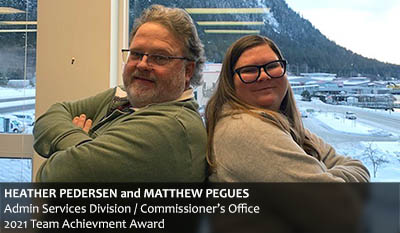 Within the first couple of weeks working for the department, Heather and Matthew were assigned the responsibility of maintaining Central Region Rural Airport maintenance contracts. They immediately jumped in and began reaching out to vendors, individuals, villages, native tribes, post offices, and any other source that could be found as they processed multiple renewals and procured new contracts while also maneuvering the challenges of working with small rural locations that are often without connectivity. Without those efforts, many rural locations were at risk of losing air service due to lack of maintenance.
Within the first couple of weeks working for the department, Heather and Matthew were assigned the responsibility of maintaining Central Region Rural Airport maintenance contracts. They immediately jumped in and began reaching out to vendors, individuals, villages, native tribes, post offices, and any other source that could be found as they processed multiple renewals and procured new contracts while also maneuvering the challenges of working with small rural locations that are often without connectivity. Without those efforts, many rural locations were at risk of losing air service due to lack of maintenance.
This team's efforts directly contributed to providing consistent access to rural Alaska locations on a year-round basis and is a perfect example of fulfilling the department’s mission to “Keep Alaska Moving through service and infrastructure” in the safest manner possible.
Stefanie Bingham
SUGGESTION AWARD
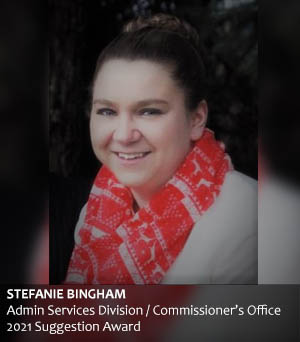 The complexity of cost accounting for the Annual Work Program has historically resulted in FHWA billing errors and a significant level of effort for reconciliation upon closeout. These issues were magnified when projects from a previous Annual Work Program converted from AKSAS to IRIS. Stephanie put forth a great effort in reviewing historic Excel files that resulted in identifying shortfalls in the old tracking system. The new system she created eliminated the shortfalls, which in turn eliminated FHWA billing errors, tied back to funding amounts on federal-aid agreements, and significantly reduced the time required for reconciliation at closeout.
The complexity of cost accounting for the Annual Work Program has historically resulted in FHWA billing errors and a significant level of effort for reconciliation upon closeout. These issues were magnified when projects from a previous Annual Work Program converted from AKSAS to IRIS. Stephanie put forth a great effort in reviewing historic Excel files that resulted in identifying shortfalls in the old tracking system. The new system she created eliminated the shortfalls, which in turn eliminated FHWA billing errors, tied back to funding amounts on federal-aid agreements, and significantly reduced the time required for reconciliation at closeout.
Stephanie is an invaluable team member with an impeccable work ethic. Her commitment to excellence is admired by many, and her efforts to develop successful and collaborative relationships with peers, project and program managers, and department leadership, has helped pave the way for success in her position.
Alaska Marine Highway System
Janet Ward
OUTSTANDING EMPLOYEE and
DEPARTMENT EMPLOYEE OF THE YEAR NOMINEE
Janet performs her duties in the galley at the highest level. She is extremely disciplined, motivated, well organized, and respected by her crew. Leading the galley crew, a busy department aboard ship, their work never ends regardless of passenger counts.
During her tenure as Chief Cook she has not only produced fantastic meals but also charmed the public with kindness and gratitude. AMHS has received numerous positive reviews from the passengers regarding her kindness and ability to communicate on a personal level with our customers. Daily, she always gives the extra effort day, and is a very valuable leader aboard the M/V Aurora.
M/V Lituya Crew
TEAM ACHIEVEMENT AWARD
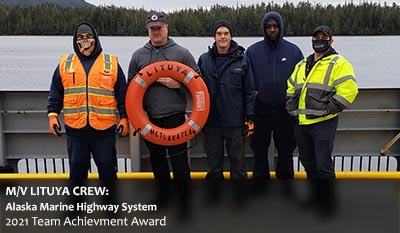 Each morning and evening, the crew of the AMHS ferry Lituya gather early and often board late a small boat to make the 10-15 minute ride to get to their vessel and then back to their vehicles to drive home. The body of water they cross is the square shaped conjunction of Revilla Channel, Tongass Narrows, and Nichols Pass which can be treacherous in bad weather and dangerous in good.
Each morning and evening, the crew of the AMHS ferry Lituya gather early and often board late a small boat to make the 10-15 minute ride to get to their vessel and then back to their vehicles to drive home. The body of water they cross is the square shaped conjunction of Revilla Channel, Tongass Narrows, and Nichols Pass which can be treacherous in bad weather and dangerous in good.
It may not be common knowledge, but the number of passengers and vehicles carried by Lituya on a daily basis exceeds those of much larger vessels. The car deck is most often full and passenger counts are high. They make four trips between ports every day.
The small crew of the Lituya handles their duties each day with complete proficiency and guardianship for the travelling public. They're responsible for all aspects of vessel operations including passenger safety and security, vessel cleaning and sanitation, passenger services, safe navigation, and engineering operations such as fueling, pumping sewage tanks, filling fresh water tanks, and machinery maintenance. They also have service and terminal responsibilities at the facility at Annette Bay. They atypically manage the dock, moorings, ramp and gate, and passenger control/accountability/security.
They maintain a top safety record and have never been found other than courteous, respectful, and dedicated. They are often seen doing things which are not required, but shines of a professional and caring team, such as helping elderly passengers walk down the ramp, assisting those in need with loading vehicles with supplies, and anything else they can do to provide a positive, enjoyable, and safe experience for our passengers.
This outstanding team is a model of success and is recognized for their daily achievement of providing top-level, safe, efficient, and profitable, ferry service of the highest standard.
Central Region
Mark Rollins, Erik Hilsinger
TEAM ACHIEVEMENT AWARD
Mark and Erik serve as cultural resources specialists in the Central Region environmental group. They handle the challenging environmental compliance areas of National Historic Preservation Act and the Alaska Historic Preservation Act, as well as other cultural resource laws which directly affect project development and execution. This past year, they have responded to unusually complex and difficult project circumstances which resulted in intensive workload requirements, extending for months. These include three in particular: Glenn Highway MP 53-56 Reconstruction Moose Creek Canyon; Aniak Airport Improvements; and Sterling Highway MP 45-60.
Erik and Mark are the linchpins who coordinate with project managers, project teams, environmental analysts, the CR Regional Environmental Manager, Statewide Environmental, project consultants, and other internal and external stakeholders in working through the considerable cultural resources challenges that have arisen on these projects. Here are two examples of important contributions from each.
-
In the aftermath of a sensitive inadvertent discovery during construction on the Aniak Airport project, in which a lead federal agency struggled with its responsibilities, Erik developed an archeological data recovery plan which was adopted by the federal agency to move the resolution process ahead. Erik's knowledge of the local history, cultural practices and the airport project details informed the inexperienced federal agency personnel's actions in their government to government consultation with the federally recognized Tribe. His preparation of the plan was a key link to moving forward on the project.
- Mark took the lead this year on coordinating the many moving parts of the Sterling Highway's cultural resources mitigation commitments in the project's Programmatic Agreement (PA). These commitments included archaeological data recovery and archaeological monitoring, contracted out to different entities-work which was critical to project delivery timelines. Mark stepped up to coordinate these cultural resource investigation activities with the region project team, contractors, partners and consulting parties. With construction occurring through the summer nights, this coordination involved outreach and response to the monitoring staff late at night, well outside his scheduled hours. The evolution of the project also required an update to the project's complex PA. Mark's ability to explain these proposed changes to the PA's signatories has been inspired, and crucial to the success of this multi-year project.
All their efforts were in addition to the pandemic-related challenges of the past year. Mark and Erik have faced intense pressure and have offered solutions that benefit the project delivery needs of Central Region, the Department, and the traveling public.
Fairbanks International Airport
Angela Spear
LEADERSHIP AWARD and
DEPARTMENT EMPLOYEE OF THE YEAR NOMINEE
As the Fairbanks International Airport’s (FAI) Airport Manager for almost 3 years, this year, especially, Angie Spear met many challenges professionally and gracefully. Angie is known for her inclusiveness. She involves her managers as appropriate in setting airport policy, participating in planning meetings, filling open positions, and attending external conferences. She is quick to acknowledge others’ work and accomplishments during in-person meetings as well as through her monthly Airport Manager Update, Final Approach, and quarterly Flight Lines publication. She readily supports her staff members’ involvement in external conferences and industry organizations such as the American Association of Airport Executives”. The nomination further said “Through hard work, a positive attitude, and a professional presence, Angie exemplifies for her employees how to leverage one’s experience for career advancement, help others along the way, and care for customers and employees. Angie’s way of leading and managing a small staff to run an important airport that has significant physical assets and required “on call” operations is admirable for its efficiency, effectiveness, and team commitment to advance the Alaska International Airport System’s Purpose: To Keep Alaska Flying and Thriving.
Craig Borba
OUTSTANDING EMPLOYEE
Over his tenure at the Airport, Craig has worked hard and moved from working in Terminal Services insuring FAI's Terminal remained world class. When a position opened with FAI's field maintenance team, Craig worked diligently with the rest of his team keeping the runway open at Alaska's second largest airport. Through his actions, Craig garnered the attention of FAI's building maintenance team where he continues to thrive. Mr. Borba is always willing to offer a helping hand to his fellow employees and continually asks his supervisor if there is more he can learn.
Rachel Webb, Katie Wilmoth, Greg Braeuer, Rafael Caldeira, Daniil Dorovskikh, Carmen Lobsinger, Timothy Vanderhoff, Clint Woodard
TEAM ACHIEVEMENT AWARD
The small runway was reconstructed and finished ahead of schedule and below budget, and the Commissioner was on hand to take part in a ribbon cutting on the General Aviation (GA) runway. The team worked collaboratively and seamlessly with consistent updates to the public and shareholder input. If a team member needed help or understanding with a task, others were willing to assist and offer institutional knowledge. The GA runway is just one project and one example of the outstanding team of individuals at FAI operations. As aviation is a constant moving industry, this team is keeping ahead and improving infrastructure for the safety of others.
Measurement Standards & Commercial Vehicle Compliance
Sarah Sperry
TEAM ACHIEVEMENT AWARD and
DEPARTMENT EMPLOYEE OF THE YEAR NOMINEE
Inspector Sperry has been with the Division of Measurement Standards and Commercial Vehicle Compliance for just short of 2 years. She started as a Weights and Measure Inspector Trainee and is now an Inspector I. When the COVID-19 pandemic developed and severely impacted the operation of Weights and Measures, Inspectors were no longer performing inspections so hands on training was not an option. Inspector Sperry took every opportunity during that time to participate in the online webinars and training with the Senior Inspectors. Throughout all of this Sarah had a wonderfully upbeat attitude which kept morale up during a stressful time.
As locations opened up to travel business, Sara was on the front lines ready to go. She worked in town inspecting gas pumps and adding extra steps to the inspection to make sure that all equipment and devices where sanitized, traveled to a small community to test at a fishing plant where she was isolated from employees and asked to adhere to the protocols of the facility, and worked with the device owners so inspections could be accomplished.
Inspector Sperry has demonstrated time and again that she is dedicated to her work, takes pride in the quality of her inspections, and respects the device owners, service providers and her fellow inspectors. MSCVE has received several emails from industry praising Inspector Sperry for a job well done.
Ingabritt Johnson
OUTSTANDING EMPLOYEE
Inga is one of those people who will help anyone with anything and do so with a smile. She has exemplified what teamwork means by stepping up to be the primary proctor for the Division; completing over 20 for Weights and Measures and four for Commercial Vehicle Compliance. Most required her to attend in person, but she also did a few CVC virtually to meet the Division’s objectives. If the front desk phones had to be covered or her teammates needed help with transponders, she was more than happy to step up. She is the type of team player that sees a teammate struggling and immediately offers to help wherever she can. Inga is an outstanding employee who exemplifies teamwork every day.
Sgt. Adam Bower
LEADERSHIP AWARD
Sarah Sperry, Sean Hannaman, Jordan Feltz, Tavis Gardin, Marjory Sanders
TEAM ACHIEVEMENT AWARD
The Anchorage Weights and Measures Team consists of Sarah Sperry (Inspector I), Sean Hannaman (Inspector I), Jordan Feltz (Inspector Trainee), and Travis Garding (Metrologist I). This team has demonstrated the highest levels of teamwork and flexibility. During COVID-19 pandemic, there were many obstacles for the Anchorage team to overcome, including travel mandates for flying into smaller communities, and restrictions on entering device owners’ facilities. The Anchorage Team came up with solutions that allowed them to conduct inspections while practicing social distancing and other preventative measures. These efforts allowed them to continue to the department's mission and ensure fairness in the marketplace by certifying the accuracy of weighing and measuring devices used in commerce.
The Anchorage Team are all relatively new inspectors. They worked together and relied upon each other to come up with the best solutions to any obstacles that were placed before them. The Metrologist I (previously an inspector) readily answered any questions they had, offered to help with any training, and shared his experiences as an inspector with the rest of the team, providing insight and suggestions.
They have all showed the utmost dedication to Measurement Standards. They take pride in their work, represent the Division and the State of Alaska admirably, and demonstrate that as a team they can accomplish goals that might have seemed unattainable.
Northern Region
Ivet Hall
OUTSTANDING EMPLOYEE and
DEPARTMENT EMPLOYEE OF THE YEAR NOMINEE
 Ivet is described by her colleagues as a hard worker, role model, and a leader with deep integrity. She invests in her staff, which she demonstrates through encouraging and facilitating professional development opportunities, organizing and facilitating onboarding sessions for new employees, and consistently diverting attention to her staff so they can take credit for their achievements.
Ivet is described by her colleagues as a hard worker, role model, and a leader with deep integrity. She invests in her staff, which she demonstrates through encouraging and facilitating professional development opportunities, organizing and facilitating onboarding sessions for new employees, and consistently diverting attention to her staff so they can take credit for their achievements.
Ivet’s commitment to her colleagues and their successes is the hallmark of a true leader. She exemplifies the department’s core values of integrity, excellence, and respect and is an invaluable asset to Northern Region.
Jacob Hendrickson
LEADERSHIP AWARD
 Jake is the M&O foreman at Montana Creek and has overseen all maintenance activities from MP 44 Steese Highway to MP 161 Steese Highway, including two mountain passes for the pasted six years. He is known as a dedicated, model employee and leader who continually provides the highest possible service to the public despite budget cuts, station closures, and staff turnover. When staffing shortages left him without a mechanic at the Montana Creek Station, he took it upon himself to troubleshoot and repair equipment so his crew could get back on the road. While mentoring and training new staff, he provides guidance and direction, but also empowers his crew to make their own decisions and take ownership of their area of responsibility.
Jake is the M&O foreman at Montana Creek and has overseen all maintenance activities from MP 44 Steese Highway to MP 161 Steese Highway, including two mountain passes for the pasted six years. He is known as a dedicated, model employee and leader who continually provides the highest possible service to the public despite budget cuts, station closures, and staff turnover. When staffing shortages left him without a mechanic at the Montana Creek Station, he took it upon himself to troubleshoot and repair equipment so his crew could get back on the road. While mentoring and training new staff, he provides guidance and direction, but also empowers his crew to make their own decisions and take ownership of their area of responsibility.
Jake serves one of the most difficult stretches of rural highway in the Northern Region with a leadership and integrity that serves as a model for us all. He truly embodies the spirit and dedication that is at the heart of what our region represents.
Lowe’s Truck Response Team: Eric Slay, Myles Comeau, and Jessica Casey
TEAM ACHIEVEMENT AWARD
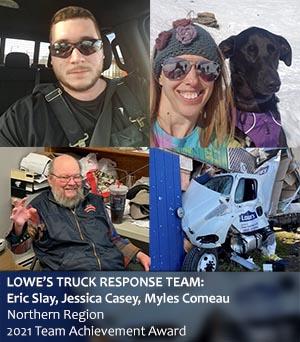 In September 2020, a Lowes shipping truck crashed into the Break Room Pool Hall on the corner of South Cushman St. and Airport Way causing damages to the traffic signals and closing the intersection. Eric, Myles and Jessica work in different sections of Northern Region but each played a role in responding to work needed to get the intersection up again.
In September 2020, a Lowes shipping truck crashed into the Break Room Pool Hall on the corner of South Cushman St. and Airport Way causing damages to the traffic signals and closing the intersection. Eric, Myles and Jessica work in different sections of Northern Region but each played a role in responding to work needed to get the intersection up again.
Eric Slay is the signals and lighting foreman in the Fairbanks M&O station and responded to the scene to assess the damaged signals. His institutional knowledge of circuit design and his responsiveness made it possible to get the signals up and running fast.
Next, Myles Comeau is an inspector with the construction section who works on signal, lighting, and communication lines. Myles is a mentor to other inspectors, project engineers, and construction staff and teaches classes during the off-season to help share the knowledge he has gained over his many years of field experience.
Jessica Casey is an administrative assistant with the Northern Region Safety Office, and is the trailblazer of NR's damage recovery program that recovers the costs of damage to our state infrastructure, including the Lowe’s truck incident. Jessica tirelessly tracks down responsible parties, police reports, and insurance companies.
The Lowes Truck Response Team is an unconventional team at a glance, but if you worked at DOT&PF, then you'd know we often work together across sections, divisions, regions and departments to do our jobs. This team is an example of how we can assemble quickly to achieve a task and how these teams are fundamental to the work we do.Laura Denty
SUGGESTION AWARD
Laura joined DOT&PF in November 2020. She has made a big impact in the department with her innovative creation of a GIS-based system for the Northern Region Right-of-Way team to track encroachments using an intuitive cell phone-accessible reporting system. Her colleagues state that she identified big problems in our reporting and database system, and that she used technology and an innovative idea to solve them with programs we already own at very little cost to the department. Laura exemplifies the great opportunities we have to solve problems when we think outside the box and work hard to find solutions.
Program Development
Margaret Carpenter
DEPARTMENT EMPLOYEE OF THE YEAR NOMINEE
 Margaret Carpenter was instrumental in setting up/working with a statewide Federal Land Access Program (FLAP) team and developing, testing and tweaking a scoring process for FLAP nominations that were submitted in the 2021 FLAP Call for Projects. These nominations and their scores were then forwarded to the Division Director for review and scoring as part of the Project Development Committee (PDC). After the FLAP projects were scored, Margaret continued to coordinate bi-weekly FLAP program calls with FHWA Western Federal Lands and the Division Office, where detailed project financial needs, schedules and issues are discussed. Margaret is very detail oriented and is always prepared with FLAP reporting meetings. Her attention to detail and ability to problem solve has helped cement relationships between all the parties and develop a friendly, sharing meeting atmosphere. Margaret has been enthusiastic in developing the FLAP program and is always willing to pitch in and work with others. She is a tremendous asset to the Division and the FFO.
Margaret Carpenter was instrumental in setting up/working with a statewide Federal Land Access Program (FLAP) team and developing, testing and tweaking a scoring process for FLAP nominations that were submitted in the 2021 FLAP Call for Projects. These nominations and their scores were then forwarded to the Division Director for review and scoring as part of the Project Development Committee (PDC). After the FLAP projects were scored, Margaret continued to coordinate bi-weekly FLAP program calls with FHWA Western Federal Lands and the Division Office, where detailed project financial needs, schedules and issues are discussed. Margaret is very detail oriented and is always prepared with FLAP reporting meetings. Her attention to detail and ability to problem solve has helped cement relationships between all the parties and develop a friendly, sharing meeting atmosphere. Margaret has been enthusiastic in developing the FLAP program and is always willing to pitch in and work with others. She is a tremendous asset to the Division and the FFO.
Nicole Stresing
OUTSTANDING EMPLOYEE
 Nicole is the clerk in the FFO section. She is a consistently upbeat, organized,
and helpful employee and has taken on more and more tasks and responsibilities over time.
She is always helpful and respectful. She is willing to jump into
any task, whether it's a little dull or exceedingly complicated and requires
research. She helps keep the
section organized and is great with spreadsheets and organizational strategies. She has excellent customer service instincts is able to discuss issues with anyone, and is able to
calm down tense situations. Nicole is the “whole package” and is an asset to the division and
the entire department.
Nicole is the clerk in the FFO section. She is a consistently upbeat, organized,
and helpful employee and has taken on more and more tasks and responsibilities over time.
She is always helpful and respectful. She is willing to jump into
any task, whether it's a little dull or exceedingly complicated and requires
research. She helps keep the
section organized and is great with spreadsheets and organizational strategies. She has excellent customer service instincts is able to discuss issues with anyone, and is able to
calm down tense situations. Nicole is the “whole package” and is an asset to the division and
the entire department.
Matt Murphy
LEADERSHIP AWARD
 Matt is an outstanding leader. His drive and self-motivation encourage his co-workers to
do the best they can. Matt expects a lot out of his
staff, and has created an environment in which it is easy to excel and fulfill
expectations. He is always willing to lend a hand and offer praise. He gives others credit, even for a
product he may have been directly responsible for. He is always looking to improve the
product that the Anchorage Field Office delivers and does so in a logical way. Matt not only does an excellent
job with motivation and improving the program, but also demands a safety conscious crew. His staff never feels they must sacrifice safety to complete a task. Matt has
become a role model.
Matt is an outstanding leader. His drive and self-motivation encourage his co-workers to
do the best they can. Matt expects a lot out of his
staff, and has created an environment in which it is easy to excel and fulfill
expectations. He is always willing to lend a hand and offer praise. He gives others credit, even for a
product he may have been directly responsible for. He is always looking to improve the
product that the Anchorage Field Office delivers and does so in a logical way. Matt not only does an excellent
job with motivation and improving the program, but also demands a safety conscious crew. His staff never feels they must sacrifice safety to complete a task. Matt has
become a role model.
Julius Adolfsson
SUGGESTION AWARD
 Julius has a challenging, yet rewarding position in which he wears two hats. Half his time is with Rural Transit and half with Statewide Bike and Pedestrian Coordination. Both roles hold enough duties be two positions. Julius is motivated
by progress and enjoys making a difference for the Department.
Julius has a challenging, yet rewarding position in which he wears two hats. Half his time is with Rural Transit and half with Statewide Bike and Pedestrian Coordination. Both roles hold enough duties be two positions. Julius is motivated
by progress and enjoys making a difference for the Department.
Julius has forged connections with his sub-recipients and helped them navigate a dynamic funding year with multiple stimulus bills that provided additional funding to transit, and a year with uncertainty as to funding eligibilities, ridership, operator concerns, etc.
In addition to the excellent service Julius provides to his transit customers, he brings passion to his work as the Statewide Bike and Pedestrian Coordinator. He has championed several efforts to further statewide bike and pedestrian planning and implement the recommendations of the Statewide Active Transportation Plan. He tracks transportation alternatives projects and provides funding approvals. He also tracks other projects with active transportation components and provides bike-ped subscribers notice of public involvement opportunities. He is helping to make better known the Department’s significant efforts in supporting Active Transportation users and developing the infrastructure.
Julius contributes to the Department’s mission through significant dedication and engagement with both of his assigned programs. He approaches this work with enthusiasm, superior performance, and a motivation to make tangible improvements to the programs.
Southcoast Region
Travis Eckoff
TEAM ACHIEVEMENT AWARD and
DEPARTMENT EMPLOYEE OF THE YEAR WINNER
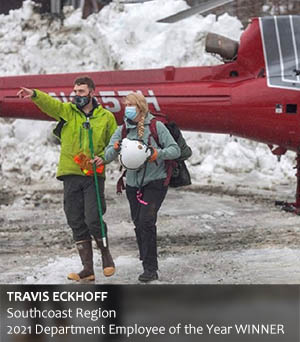 Travis Eckhoff works in the Southcoast Region Materials Section and is outstanding and extraordinary employee, especially when Southeast Alaska experienced a series of unprecedented storm events in early December 2020. For several days, torrential rains and rain-on-snow events triggered flooding initiating numerous debris flows and landslides. The communities of Haines, Juneau and Skagway were the most impacted, with transportation infrastructure sustaining significant damage and interruption. Of all the damage sustained in Southeast Alaska, the greatest struck the community of Haines. Saddest of all was the loss of two lives from a massive landslide, leaving an enormous physical and emotional scar and a constant reminder of the devastation that fell on this community just 10 months ago.
Travis Eckhoff works in the Southcoast Region Materials Section and is outstanding and extraordinary employee, especially when Southeast Alaska experienced a series of unprecedented storm events in early December 2020. For several days, torrential rains and rain-on-snow events triggered flooding initiating numerous debris flows and landslides. The communities of Haines, Juneau and Skagway were the most impacted, with transportation infrastructure sustaining significant damage and interruption. Of all the damage sustained in Southeast Alaska, the greatest struck the community of Haines. Saddest of all was the loss of two lives from a massive landslide, leaving an enormous physical and emotional scar and a constant reminder of the devastation that fell on this community just 10 months ago.
Travis Eckhoff is the DOT&PF Southcoast Region Geotechnical Engineer. He has logged many years working for and with the DOT&PF in many capacities, serving in his present role for nearly three years. The unique situation brought about by the December 2020 emergency thrust Travis into a role to which he rose to the occasion. His actions in response to the challenges facing a hurting community were outstanding. Travis's continual and direct involvement with emergency responders, numerous emergency agencies and commands, clean-up crews, city officials, and federal and statewide agencies made him an integral part of the Emergency Response team.
His leadership and technical professional contributions in this incident involved countless number of public and internal briefings, where he collaboratively supported and contributed to a community that became increasingly weary and fearful with each passing day following the disaster. The logistical, institutional, and emotional complexities associated with the incident were complicated and challenging and difficult to manage. Travis was unflinching in his role when the community of Haines and DOT&PF needed him the most.
With initial support from the SR Material Group team members Mitch McDonald, Martin "Mort" Larsen and Ken Pyeatt, these individuals were among the first to respond to the devastation. Mr. Eckhoff was the go-to, boots-on-the-ground technical support and communications link between the DOT&PF and the community of Haines. He relayed timely information, collected data and assessed and inventoried damage not only in Haines, but eventually in Juneau and Skagway. This information was sent to SR Materials group Team members, who summarized and reported the situation to management on a daily basis.
His presence was not only sincerely appreciated, but his technical expertise in the field of geotechnical engineering was frequently sought by many. He monitored slope stability in potentially vulnerable areas, conducted on-the-ground and helicopter surveys of impacted areas, participated in recovery efforts, measured groundwater levels/pressures, and continued to assess, qualify, and quantify the extensive damage to DOT&PFs infrastructure from the storm. Travis logged nearly 90 hours of additional work, (and likely much more), within the first 20 days following the incident.
In addition to providing timely logistics and technical support to DOT&PFs Maintenance & Operations across the SR, he engaged as a technical professional expert for a number of entities including: DOT&PF Maintenance and Operations, the Haines Borough Emergency Operations Command (EOC), Haines Borough, United States Geological Survey, USGS), the Alaska Division of Geological & Geophysical Surveys, {DGGS), the Alaska Department of Military and Veteran Affairs (DMVA), and the Alaska State Troopers.
As experts began to depart Haines, there was a realization by many that a plan to move forward was needed. The Haines community faced the reality of potentially dangerous, long term geo-hazards existing in and around Haines. Perhaps most daunting to the residents and the local government was the stark uncertainty as to what to do next; where do we go from here? It became apparent that the Haines EOC/Borough clearly needed direction to transition from the frenzy and fear of the early days of the emergency to the next step of recovery and how to address what was still an unknown hazard at the time. In short, the Haines community was in dire need of post-incident geotechnical engineering assistance.
With support and guidance from our Regional Director Lance Mearig and the Commissioner's office, Travis and the SR Materials Team knew they could help the Haines EOC/Borough in this next phase of transition. The Team prepared a way forward to secure and manage a longer-term contract involving experts outside of DOT&PF. The intention was to guide the Haines EOC/Borough through post-storm monitoring of potential geo-hazards and secure a consulting firm to assist them with identifying areas of instability and providing geotechnical advice.
With expert assistance from Mr. Mitch McDonald, SR Engineering Geologist, Mr. Eckhoff initiated and provided the Haines EOC/Borough a scope of services needed to ultimately procure geotechnical expertise. Today, Travis manages this multi-million-dollar contract as work progresses to characterize and monitor unstable lands, providing the Haines Borough vital information to make informed decisions. At the same time, Travis continued to perform tasks associated with qualifying FEMA and FHWA reimbursements that address damaged DOT&PF infrastructure, estimated to be upwards of $15M for the Haines area alone.
Travis continues to further assess the damage in both Haines and Skagway, providing additional estimates and proposing repair options for dozens of sites. He is assisted by the SR Materials Team of Mitch McDonald, Martin Larsen and Ken Pyeatt in the complex task of organizing and consolidating immense data sets from multiple sources and applications. This task required the close coordination of a number of parties including DOT&PF Maintenance, SR Administration, OIT/GIS Geospatial Services Section, SR Reconnaissance, SR Pre-construction and SR Contracting. The innovation behind the organization and presentation of the collected data is not only impressive, but unprecedented to many DOTs across the country.
Detailed cost and work task estimates were provided to FEMA in February 2021, within two months of them being requested. In the process, this data was geo-referenced, another accomplishment performed entirely by in-house staff. The SR Materials Team combined GIS/Arc technologies with classic field geotechnical and geological processes, resulting in a thorough, accurate, and targeted assessment of DOT&PFs infrastructures' condition after the emergency. Again, all of this was accomplished in house in a matter of weeks.
The shock that this community experienced in the first few days of December cannot be entirely described in words. Travis, his support Team and DOT&PF management helped the Haines community in the months after first responders and technical staff departed in a truly professional and compassionate way. Concurrently, Travis worked to assist in the restoration of damaged critical DOT&PF infrastructure not only in Haines, but in other hard-hit parts of the SR. This is in addition to his duties to provide geotechnical design services to keep the SR design and construction programs moving.
Travis's untiring presence and many contributions during that time of devastation, loss of life, and recovery filled a void that the community desperately needed. His professional character and caring attitude is invaluable to communities across the SR. Thus, it is my privilege to nominate Travis Eckhoff for the Outstanding Employee Award, 2021, in recognition of his outstanding service toward communities in need, his extraordinary technical professional abilities and endurance in times of emergency, all of which contributes to his consistent deliverance of top-notch work every day to the Department and to the people of the State of Alaska.
H. Erik Pedersen
OUTSTANDING EMPLOYEE
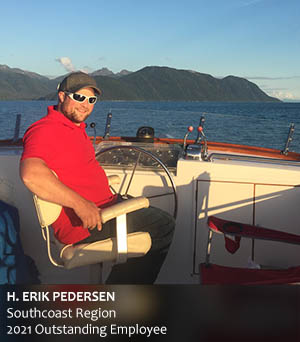 Erik serves as the Land Survey Manager for the Southcoast Region Right of Way Section. For the past year he has also served as the Locational Land Survey Supervisor. Both positions require an enormous amount of logistic and supervisory skills which Erik has fulfilled with great skill and adaptively. His professional competency and even-keeled temperament have been invaluable during an extremely difficult and stressful period of project development and completion.
Erik serves as the Land Survey Manager for the Southcoast Region Right of Way Section. For the past year he has also served as the Locational Land Survey Supervisor. Both positions require an enormous amount of logistic and supervisory skills which Erik has fulfilled with great skill and adaptively. His professional competency and even-keeled temperament have been invaluable during an extremely difficult and stressful period of project development and completion.
Erik is an exceptional leader who continues to motivate and encourage his team by facilitating individual team members to develop ownership of project successes and challenges. He does this by continually providing and promoting professional development and as a role model of Professional Land Survey standards. His team states he is motivating, inspiring, and he always gives them credit for their achievements and assists them in finding their own workable practical solutions in their trials. He demonstrates a passion and commitment to DOT&PF’s values, visions and goals. He is a role model of excellence for which his team shows great affinity and to whose standards they strive.
Outside municipal and borough governments rely on survey information and research from his team frequently. His ability to analyze survey data and records to develop appropriate assistance has made him an irreplaceable resource for which the department receives praise continually. His fellow supervisors and project managers see him as a “go-to” guy. His team members make these statements:
-
“Erik’s ability to supervise both the right-of-way design section and the survey/locations section simultaneously is nothing short of miraculous. He is able to keep everyone working towards a common goal and ensure every project is moving toward completion. With his approachable and laid back style he is able to bring out the best in his team while keeping them focused on the task at hand.”
-
“He is very approachable and easy to work with, good at taking care of multiple tasks at once, gives positive feedback on things you have done well and trains you on tasks you can do differently or better in the future. He was able to manage multiple employees in two different departments during a pandemic with a mix of employees at home and at the office, and a travelling survey crew.”
-
“His affable and approachable nature makes it easy to want to do our best for him.”
Steve Bell
LEADERSHIP AWARD
 Steve is a great leader and an outstanding employee. He has accomplished many successes over the past year that are vitally important to Southcoast Region. He inherited many challenges and has worked doggedly to overcome them.
Steve is a great leader and an outstanding employee. He has accomplished many successes over the past year that are vitally important to Southcoast Region. He inherited many challenges and has worked doggedly to overcome them.
The most recent airport inspections in Steve's district by the TSA and FAA have gone from unsatisfactory to the best the station has ever seen.
Steve does what it takes to accomplish what is needed at a station. His work on various building-related needs has successfully restored function to many vital systems. His localized efforts have saved considerable funds.
Despite the challenges of COVID-19 in the past year, Steve managed to travel to many of his stations to assist foremen through coaching, mentoring and leadership, who were on their way to successfully manage an airport or station. He thinks outside the box and always offers ideas to help address Maintenance & Operations’ (M&O) budget challenges.
Steve's leadership and mentoring of the local station M&O foreman and staff has led to great turnarounds. His staff have learned and excelled at keeping their airports and stations performing at a high level.
Haines Storm Response Team: Matt Boron, Pat Carroll, Toni Dotson, Travis Eckhoff, Daniel Fitzpatrick, Zackery Ferrin, Christopher Downer, Christopher Goins, Scott Gray, Jeff Jenkins, Mort Larsen, Mitch McDonald, Kirk Miller, Joel Osburn, Kenneth Pyeatt, Victoria Roberts, Vincent Traudt, Robert Trousil, William Williamson, Marcus Zimmerman
TEAM ACHIEVEMENT AWARD
The Haines Storm Response was the first Federal Disaster in Southeast Alaska and the second in the state in the past two years. The entire team came together to assess the needs of the Haines community. They immediately joined forces with other local response groups to coordinate efforts and continue to support the recovery efforts nearly nine months after the initial disaster.
Maintenance & Operations (M&O) worked around the clock to keep roads open and even dealt with a significant snow event in the middle of the disaster. All of this while balancing the challenges and stress caused by the storm’s impact on their community, friends, and family.
The Haines employees went above and beyond. They worked tirelessly to repair damage and open roads while dealing with the effects of the disaster on their community. A few were under evacuation orders during the event and still showed up to work, some even volunteered at shelters after work.
The Haines crew responded to this disaster for endless days, well into the dark of the night. The crews worked in the most dangerous areas along the Haines and Lutak Highways, clearing debris from the roads and culverts so people could evacuate those areas.
The Materials Team of Mitch McDonald, Mort Larsen, Travis Eckhoff, and Ken Pyeatt combined GIS/Arc technologies with classic field geotechnical and geological processes, resulting in a thorough, targeted assessment of DOT&PF infrastructures' condition after the emergency. No third party could have delivered this combination of tasks in such a short time frame or at such a low cost.
Zack Ferrin, Toni Dotson, and Matt Boron learned new tech on a Saturday morning before dawn and implemented this technology to document damage and provide live updates to damage conditions allowing better planning. M&O staff were first responders on the scene, working long hours for weeks on end during the response effort.
Vicky Roberts and Marcus Zimmerman hired and managed an experienced Emergency Response (ER) consultant to assist with field damage documentation, consulted with Central Region to establish proper funding codes and learn from their 2018 earthquake response, while coordinating with FEMA/FHWA and legislative/Governor’s office efforts to declare a Federal Emergency.
This team of individuals came together to support the community of Haines in every way possible at all hours of the day and night, exhibiting the high values of the Department in the face of great adversity and sorrow in last winter’s Haines emergency.
Jessica Eller
SUGGESTION AWARD
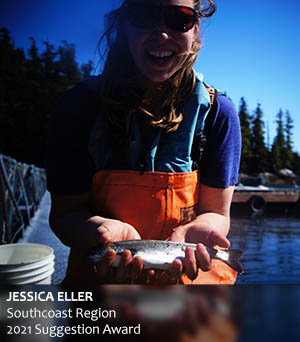 Jessica is an Environmental Impact Analyst within Southcoast Region's (SR) Preconstruction section. She is a valuable asset to the environmental section and DOT&PF as a whole, demonstrated by her strong work ethic, motivation to complete projects, vast expertise in all things environmental, and exceptional work on Perfluoroalkyl Substances (PFAS).
Jessica is an Environmental Impact Analyst within Southcoast Region's (SR) Preconstruction section. She is a valuable asset to the environmental section and DOT&PF as a whole, demonstrated by her strong work ethic, motivation to complete projects, vast expertise in all things environmental, and exceptional work on Perfluoroalkyl Substances (PFAS).
Jessica recently provided important coordination and analysis work associated with the Gustavus Airport project which encountered contaminated materials (PFAS) after the project was awarded for construction. Faced with significant delays and costs, the project was nearly cancelled. Working closely with our construction department, Jessica provided research and organized and developed solutions which involved close coordination with outside regulatory agencies and a highly concerned public. Due to Jessica’s efforts, the project was able to proceed to completion in a single construction season. Significant savings in time and cost were realized by the department. She is also a very knowledgeable and helpful member of the environmental team at SR. She is always ready to solve problems and complete environmental work products necessary to keep our projects moving.
Jessica took on the lead role of becoming knowledgeable in the area of PFAS contamination in regards to the Gustavus Airport Rehabilitation, in which she devoted many, many hours in researching, presenting, and reviewing all PFAS related management plans in order to keep the project moving forward. Aside from handling project tasks, she has been instrumental in assisting the Environmental Section come up to speed with recent USC 327 assumption from FHWA. She is always enthusiastic to take on new challenges and successfully meets her deadlines. Her personable attitude and work ethic has garnered many accolades from project teams and supervisors.
She deals with many complicated and challenging issues in construction which have significant health, financial, and regulatory consequences. In each of these instances, she has risen to the occasion to an exceptional level.
Statewide Aviation
Ryan Marlow
OUTSTANDING EMPLOYEE and
DEPARTMENT EMPLOYEE OF THE YEAR NOMINEE
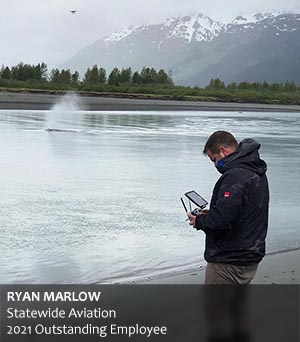 Ryan Marlow is the DOT&PF lead for unmanned aerial systems (drones) within the State of Alaska and a leader for Statewide Aviation's purpose: "To sustain and improve the quality of life throughout Alaska." Ryan leverages drone use across Alaska by partnering with the Alaska Center for Unmanned Aircraft System Integration (ACUASI) and the Federal Aviation Administration FAA. He provides support by communicating with private and non-profit drone user groups, applying for drone grant funds, and works with both the statewide GIS database and the Survey and Instrument Lab teams to improve the information collected at various state-owned airports.
Ryan Marlow is the DOT&PF lead for unmanned aerial systems (drones) within the State of Alaska and a leader for Statewide Aviation's purpose: "To sustain and improve the quality of life throughout Alaska." Ryan leverages drone use across Alaska by partnering with the Alaska Center for Unmanned Aircraft System Integration (ACUASI) and the Federal Aviation Administration FAA. He provides support by communicating with private and non-profit drone user groups, applying for drone grant funds, and works with both the statewide GIS database and the Survey and Instrument Lab teams to improve the information collected at various state-owned airports.
Ryan's accomplishments this past year include opening a DOT&PF Flight Facility at Eklutna for remote control/drone use, obtaining a STIC grant for using drones in avalanche mitigation, coordinating a first-in-the-nation drone operation to collect aerosol data over Makushin Volcano, maintaining the SOA UAS website, and providing drone training to employees for projects, (e.g., wildlife monitoring, bridge inspections, and material stockpile measurements, etc.) One of his primary focuses has been leading and coordinating with other state agencies to improve efficiencies through policy and procedure development and data storage identification to save DOT&PF money and time. His ability to collaborate, coordinate, and work with different people and organizations inside and outside our department can be seen through his inclusive, forward-thinking stakeholder management style. He is an outstanding employee and an innovative thought leader at DOT&PF.
Troy LaRue
LEADERSHIP AWARD
Troy LaRue, Division Operations Manager (DOM), is responsible for leading Statewide Aviation. He is responsible for the supervision of SWA’s safety, digital mapping, leasing and planning team. He is also responsible for overseeing long-term planning and vision efforts regarding the organizational structure and performance measures and tracking, as well as future budgeting requirements, such as capital and operating budgets tracking airport revenues.
Troy exceeds the expectations of what exemplifies a strong leader. He promotes professional development of not only the position a person holds but encourages professional development in overlap areas in order to broaden the knowledge base, which instills confidence when performing day-to-day tasks. He is constantly encouraging his employees and regularly nominates them for awards and/or recognizes their accomplishments during group gatherings.
Troy brags about the SWA team, and seizes opportunities to highlight projects his staff are working on. His decades of departmental historical knowledge helps his employees to perform their duties to the best of their abilities. His dedication and longevity helps forge incredible working relationships with his peers across the state, allowing him to make introductions and/or find unique and innovative solutions. His staff are confident in knowing they have the ability to make decisions that are in the best interest of the state or that they can reach out to him anytime for collaboration and guidance.
Troy has excelled exceptionally as a leader throughout the course of the ever changing pandemic, navigating the challenges that come with employees working from home and in the office. Troy’s leadership, dedication and flexibility shines through the accomplishments of his teams to continue meeting the department’s mission and perform tasks that otherwise would have been cancelled due to evolving restrictions surrounded by COVID-19.
Troy’s cheerful and optimistic personality coupled with his dedication to the department’s values, visions and goals motivates and inspires those around him and those he leads to perform at optimal levels regardless of the hurdles placed in front of them.
Gustavus Airport Internal Team: Sam Dapcevich, Jessica Eller, Angelo Saggiomo, Sammy Cummings, John Kajdan, Bill O'Connell, Chuck Tripp, Travis Eckoff, Jeff Jarvis, Garrett Paul
TEAM ACHIEVEMENT AWARD
This team was exceptional at handling a very serious health concern regarding PFAS in Gustavus on the Gustavus Airport project. This team was the first in the nation to discover PFAS could remain on Asphalt for years after application of firefighting foam. They took a project on the verge of being completely shut down, and worked nights, weekends, and in the face of high pressure from the community and contractor to work the challenge, always placing public health as the top priority while ensuring the contractor could keep working.
This team was able to develop risk mitigation plans designed to protect the community, staff, and contractors while maintaining momentum on project progress and reducing PFAS contaminated materials at completion. They did all of this by working hand in hand with DEC, DNR, FAA, the contractor, and the community. The effort to do this was monumental and this internal team came together like few I have ever seen to support the community and project. They exemplified the highest standards of public servants seeking to do the right thing from the community, our funding partners, and our construction partners.
In the end, the project was paved out about a year ahead of schedule during a very poor paving summer, and seems to have left the community and airport in a better position than before, in relation to PFAS. It is teams and moments like these that make us very proud to serve with such exceptional individuals.
Rebecca Douglas
SUGGESTION AWARD
Becca started managing the Alaska Aviation System Plan (AASP), the largest state managed aviation system plan in North America, in 2014 during its 2nd phase. The AASP project provides information, funding and solutions to both state and local sponsor airports and the stakeholders who rely on aviation. The AASP website enables the most comprehensive repository of airport and aviation information to increase the efficiency of aviation planning and program development across the state.
Becca is a visionary and her dedication to her work has increased the effectiveness of the State of Alaska’s aviation program. She has an exceptional reputation among the aviation community across Alaska as she works with a vast amount of people within and outside of the department on a daily basis. Some of her strengths include communication, organization, innovation and dedication. She carves out the time to talk through challenges to find innovative solutions the work for everyone and meets the needs, missions and objectives of the department.
Becca’s ability to identify projects outside of her own benefits the department in its entirety and increases efficiencies. She works with her peers to obtain information as efficiently as possible with little impacts to their day-to-day operation in order to incorporate them into the AASP. Under Becca’s management the AASP program is constantly finding innovative ways to implement and/or incorporate her peer’s programs into the AASP to ensure the program is all encompassing. The AASP program is constantly expanding the depository of information available to department members and contractors and resulting in an historical archive of airport information.
Due to the relationships she’s built she is often the “go-to” contact person when there is a challenge and not an obvious solution. Becca will ensure that she either helps her peers find a solution or will know where to find the contact that can help if she is unable to. Becca’s ability to communicate and truly listen to others and respond in a manner that acknowledges and addresses the wide variety of priorities, opinions and agenda of divisions outside of her own has contributed to the success of the AASP and its success at meeting the department’s objectives.
Ted Stevens Anchorage International Airport
Corporal Casey Meade
DEPARTMENT EMPLOYEE OF THE YEAR NOMINEE
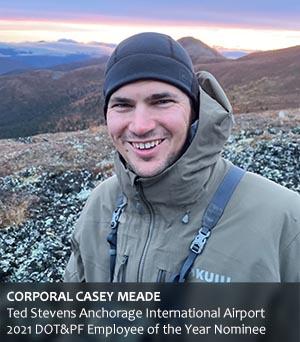 Corporal Meade serves as the ANC Police and Fire Department’s Executive Officer. He ensures all officers are up to date on CALEA accreditation police standards. He is also responsible for Recruitment, Social Media management and postings, Emergency Tri-annual planning and implementation, Special Event Functions, and Adak Coordination; making sure an ANC law enforcement officer is scheduled, ticketed, has the proper training and clearance for travel, and is present in Adak twice a week.
Corporal Meade serves as the ANC Police and Fire Department’s Executive Officer. He ensures all officers are up to date on CALEA accreditation police standards. He is also responsible for Recruitment, Social Media management and postings, Emergency Tri-annual planning and implementation, Special Event Functions, and Adak Coordination; making sure an ANC law enforcement officer is scheduled, ticketed, has the proper training and clearance for travel, and is present in Adak twice a week.
Cpl. Meade is a Use of Force Instructor and is responsible for Response to Resistance reporting standards and policy updates. He is the reason the Water Rescue Team for Cook Inlet Response is where it’s at today. He built up the program, trained officers, ensured a properly equipped, capable and reliable response to aircraft incidents in large bodies of water, in support of the Airport Emergency Plan. He is a founding member of the Department’s Honor Guard serving in remembrance of fallen officers, Color Guards for all occasions, dignified transfers for deceased veterans, and other functions, where dignity and professionalism are a must. Cpl. Meade is a respected officer with his peers and those he encounters, maintaining high moral character. He is the kind of Police and Fire Officer the public expects in the service of the community and at the Ted Stevens Anchorage International Airport.
Officer Crystal Miller
OUTSTANDING EMPLOYEE
 Officer Miller has been with the department since 2007 and has taken on many tasks while assigned to Anchorage Airport Police and Fire. She has been a Fire Academy instructor where she was a primary instructor for the Aircraft Rescue Fire Fighting Academy. She also served as the department's Task Force Officer (TFO) assigned to the DEA where she aided them in confiscating and seizing countless amounts of drugs and items associated with drug trafficking. Her time at the team made a significant impact on the drug trafficking issues in Anchorage and across Alaska.
Officer Miller has been with the department since 2007 and has taken on many tasks while assigned to Anchorage Airport Police and Fire. She has been a Fire Academy instructor where she was a primary instructor for the Aircraft Rescue Fire Fighting Academy. She also served as the department's Task Force Officer (TFO) assigned to the DEA where she aided them in confiscating and seizing countless amounts of drugs and items associated with drug trafficking. Her time at the team made a significant impact on the drug trafficking issues in Anchorage and across Alaska.
Officer Miller is committed to team excellence. She has received numerous ‘thanks’ from her co-workers and other staff members for her explicit attention to detail and follow-through. She has been involved with two cycles of new hire evolutions which involve a significant amount of effort. In those instances, she was overly prepared for each new hire and had all their equipment ready when they arrived. Whenever anyone in the department needs help with a supply issue, Officer Miller is the go-to individual they seek out. She continues her duties as officer and Field Training Officer (FTO) while balancing all these other duties.
Lawrence Swanson
LEADERSHIP AWARD
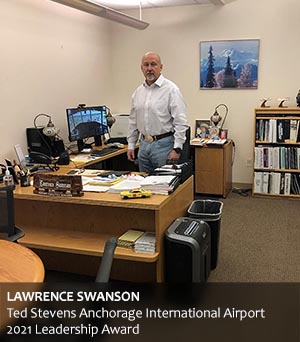 It takes time to prepare the terminals for the significant increase in passengers during the summer. With the COVID-19 pandemic still present, ANC management asked for a number of changes to the terminals so that passengers would feel safe at ANC.
It takes time to prepare the terminals for the significant increase in passengers during the summer. With the COVID-19 pandemic still present, ANC management asked for a number of changes to the terminals so that passengers would feel safe at ANC.
Larry motivated his team and they utilized their natural talents to accomplish many tasks in a short time. To get ready for the summer Larry and his team activated a new airline gate area, established an outdoor gate area, installed building monitoring message boards on air quality in the terminal, rearranged seating to meet the needs of the terminal, converted the entire public side of the airport to “touchless” for all restrooms and water fountains, procured and installed U-VC sanitizing lights on the escalator hand rails, continually updated the signage with changing mandates, coordinated the recommissioning of the airport’s baggage system, began projects to prepare the North Terminal for next summer, and other smaller projects. Larry’s leadership skills helped in assembling small teams of the right mix. He saw that his team could use their ingenuity to accomplish the tasks in short order.
Operations, Security and Safety: Deana Shawback, Elizabeth Goodwin, Raquel Pazos-Fuentes, Sandra Roddy, Aaron Hawk, Faepa Foster
TEAM ACHIEVEMENT AWARD
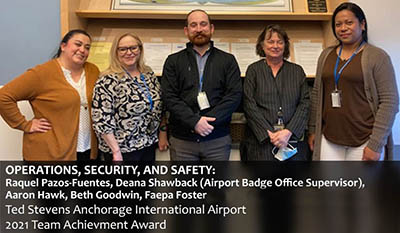 Ted Stevens Anchorage International Airport employs 1 in 10 workers in Anchorage. About 9,400 of them must have an airport identification badge to access their work area. When you combine new and renewal badges, the Badge Office has nearly 20,000 customer visits annually. The Badge Office was, until recently, a three-person office with one supervisor, it is now a four-person office with one supervisor - still a relatively small team for such a large customer base.
Ted Stevens Anchorage International Airport employs 1 in 10 workers in Anchorage. About 9,400 of them must have an airport identification badge to access their work area. When you combine new and renewal badges, the Badge Office has nearly 20,000 customer visits annually. The Badge Office was, until recently, a three-person office with one supervisor, it is now a four-person office with one supervisor - still a relatively small team for such a large customer base.
In normal times the Airport Badge Office plays a critical role in keeping the airport operating, but recent events placed a premium on their service. Although airline passenger traffic dwindled to less than a third of normal in 2020 and early 2021 due to the pandemic, air cargo activity saw an increase of almost 30%. Due to the pandemic, airport tenants experienced a high personnel turnover rate as they first downsized and then built back up again, and the Badge Office was inundated with historically high demand. Staff stayed late and worked weekends to process as expediently as possible.
This amazing group of people have worked through some very difficult times and remained professional and efficient.
Statewide Design & Engineering Services
Jesse Escamilla
OUTSTANDING EMPLOYEE and
DEPARTMENT EMPLOYEE OF THE YEAR NOMINEE
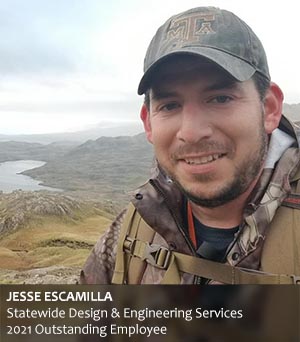 Jesse Escamilla designs, builds and inspects bridges in Alaska and represents DOT&PF nationally by serving on numerous research grants and transportation committees. Jesse is a highly skilled drone pilot who brings an infectious degree of energy, commitment, flexibility, and professional conduct to safe integration of drone technology into bridge and infrastructure inspection programs.
Jesse Escamilla designs, builds and inspects bridges in Alaska and represents DOT&PF nationally by serving on numerous research grants and transportation committees. Jesse is a highly skilled drone pilot who brings an infectious degree of energy, commitment, flexibility, and professional conduct to safe integration of drone technology into bridge and infrastructure inspection programs.
Jesse goes above and beyond to provide significant feedback and support to the development of drone integration, 3D scanning, and image processing. He is driven and taught himself how to perform 3D scanning and image processing in a week, a task that takes most people years to master. His dedication to his work and ability to communicate effectively has placed the department's bridge design group on the map as innovators with FHWA and as influencers for the drone industry. It is common for drone and software companies to ask Jesse to review their products because his notes and criticism is highly valued across the nation.
Jesse's work is leading the nation for drone integration, while paving the way for the department on significant cost savings. Jesse exemplifies the qualities of what it means to "keep Alaska moving though service and infrastructure.”
Kathy Price
LEADERSHIP AWARD
Kathy Price, Cultural Resources Manager, provides leadership and advice to regions and SEO on cultural resources; her intelligence, experience, and communication skills make her an invaluable leader in this field. She leads the Cultural Resources Team (CRT), a group comprised of employees qualified for Section 106 under the Secretary of the Interior’s Professional Qualification Standards (PQIs) from all three regions, SEO, and includes the DOT&PF Liaison at the State Historic Preservation Officer (SHPO)’s office.
When PQIs run into difficult situations, they consult Kathy for help. At any given moment, she may be providing advice, reviews, or content to regions to negotiate these difficult situations. Her in-depth knowledge has been critical in developing agreements with other agencies, and her communication skills are always useful when discussions include SHPO or other agencies. She leads by example, stepping into these difficult situations and searching for the path forward.
After the Southcoast Region PQI retired, Kathy promptly prioritized her time to research, review, and provide direct coaching so projects could proceed. It is evident in every interaction with Kathy that she not only values the successes of the department but also the professional development of employees.
Her experience, intelligence, and work ethic, and thoughtfulness, make her a strong leader and a valued co-worker.
Meagan Sharp, Brandy Milles, Aryan Azarsepandan, Brian Braeutigam, Willow Graber, Dave Lee, Lucas Bowers, David Eguires-Less, Laura Paul, Andrew Schultz, Paul Garrett, Christine Langley, Caitlin Frye
TEAM ACHIEVEMENT AWARD
The AASHTOWare Project certified payroll team was tasked with implementing the Certified Payroll component of the AASHTOWare Project software package. This component streamlines the submission of certified payroll for contractors and the state agencies and staff who receive and approve it. Implementing this component, however, was no straightforward task. It required extensive interagency coordination, constant trouble-shooting and process adjustments, and comprehensive training and outreach for agency and contractor staff. The extent of this monumental task cannot be underestimated.
Staff from three different departments came together six months prior to the Certified Payroll component’s go-live date of January 1, 2021. Their focused and consistent work on this difficult project corralled it from overwhelming chaos to a streamlined success.
Before the AASHTOWare Project Certified Payroll component was implemented, prime contractors were required to submit certified payroll to the Department of Labor and Workforce Development (DOL&WD) with all social security numbers displayed and then submit a separate version with redacted social security numbers to DOT&PF. Subcontractors had to do the same with the added burden of also sending the paperwork to the prime contractor—three separate submissions. These certified payroll submissions came in paper form, via email, and through the DOL&WD electronic system. This inefficient process resulted in mistakes, lost documentation, and excessive staff time to scan, print, and file payroll to create an official DOT&PF project archive. It also resulted in audit findings each year from the Federal Highway Administration and Federal Aviation Administration due to missing paperwork.
Between mid-2020 and January 2021, the AASHTOWare Project team had to design a system that met the needs of DOT&PF, DOL&WD, and the contracting community. Although consultants performed the software programming, the team had to research departmental regulations, test for functionality, and then design for ease of use by all users. Contractor staff range from technically savvy teams of accountants to one-person operations, sometimes without the use of a computer. The team had to ensure that this system would be feasible for all our partners who work on DOT&PF projects, regardless of technical capability.
The team also defined a strategy for training users on the new system. Each group (DOT&PF staff, DOL&WD staff, consultants, and contractors) required a different type and approach to training. In order to accommodate all learning types, the team developed written materials, simulated computer scenarios, and live demonstrations in both large and small group settings. They have also fielded hundreds of individual questions in weekly public forums, emails, and phone calls, all while adjusting to the limitations brought on by the pandemic.
The end result of the implementation of this component is a streamlined process that saves the contractor and agency staff time and money. Contractors now only submit certified payroll through one system that all the state agencies can access, reducing the burden on contractors and duplicative efforts across agencies. The new system is more secure and protects personal information like social security numbers. It also automatically archives all records and ensures all required documentation is submitted, which will bring DOT&PF into 100% compliance with certified payroll regulations, resulting in no significant findings the next time files are audited.
The implementation team was able work with the Department of Administration to reduce the number of steps in the vendor registration process, making it easier for vendors to do business with the State of Alaska. The new technology also reduces the data entry burden, reduces errors in certified payroll, and confusion about the submission process for contractors and state employees. Open and clear communication between all parties is now the standard.
Without the extensive training, outreach, and excellent customer service provided by all members of the team, this project could not have achieved its desired result. Change is hard and the team’s rapid response to issues as they arose made the transition easier on staff and contractors. The team’s commitment to this multi-department project is the sole reason for its tremendous success. Thank you for considering them for well-deserved recognition.Mary McRae
SUGGESTION AWARD
Statewide Equipment Fleet
Raymond "Gil" Martel
OUTSTANDING EMPLOYEE and
DEPARTMENT EMPLOYEE OF THE YEAR NOMINEE
Frank Siemion
LEADERSHIP AWARD
Eric Wilkerson, Richard Asplund, Clark Mondich, Ryan Kirtley, Dorion Hobbs, Mike Davis, Randy Sutak, Linda Palmer, Lisa Palmer, Robert Henricksen, Cody Shaw, Jeff Martin, Bill Miller, Roger Hoffman, Jake Olivit
TEAM ACHIEVEMENT AWARD
Statewide Facilities Services
Michael Melbostad
DEPARTMENT EMPLOYEE OF THE YEAR NOMINEE
Michael Melbostad is a top level senior project engineer for Statewide Public Facilities whose collaboration and contributions build strong teams. An example of his character over this past year was his ability to lead as project engineer for the DOC Palmer Correction Center Renovation project, a highly visible project that demanded coordination amongst many high level stakeholders. This project had some challenging facets to it and Michael lead the team successfully through coordination amongst DOC high level stakeholders, DOC project members, construction contractor members, and design team members. Quick to solve problems in demanding construction environments, Michael is well regarded by his peers and clients and builds successful teams and projects. His approach to this project, ability to build teams, and coordinate successfully displays what it means to be an exceptional employee for the department.
Anne Hughes
OUTSTANDING EMPLOYEE
Danny Gibson
LEADERSHIP AWARD
Sitka M&O Team: Mark J. Davis, Steve Dunn, Justin Lark, Stanley Johnson
TEAM ACHIEVEMENT AWARD
Christopher Hodgin
SUGGESTION AWARD
Christopher has recieved multiple outstanding employee and leadership award nominations. An example of the statements about him:
- "Christopher Hodgin demonstrates excellent leadership qualities by acting as a servant leader, supporting his team, enabling them to carry out their mission, and providing an example of what it means to be committed to excellent."
Christopher has worked hard to improve the Division of Facilities Services as a whole including indroducing cost saving processes and filling in at the director level when the Division Director is unavailable.


